Cardiovascular Disease: Causes, Prevalence, and Impacts
VerifiedAdded on 2023/03/23
|14
|4051
|40
AI Summary
This article discusses the causes, prevalence, and impacts of cardiovascular disease on individuals, families, and the Australian population. It also outlines a government strategy to prevent and control this condition and explores the role of registered nurses in addressing cardiovascular disease in Australia.
Contribute Materials
Your contribution can guide someone’s learning journey. Share your
documents today.
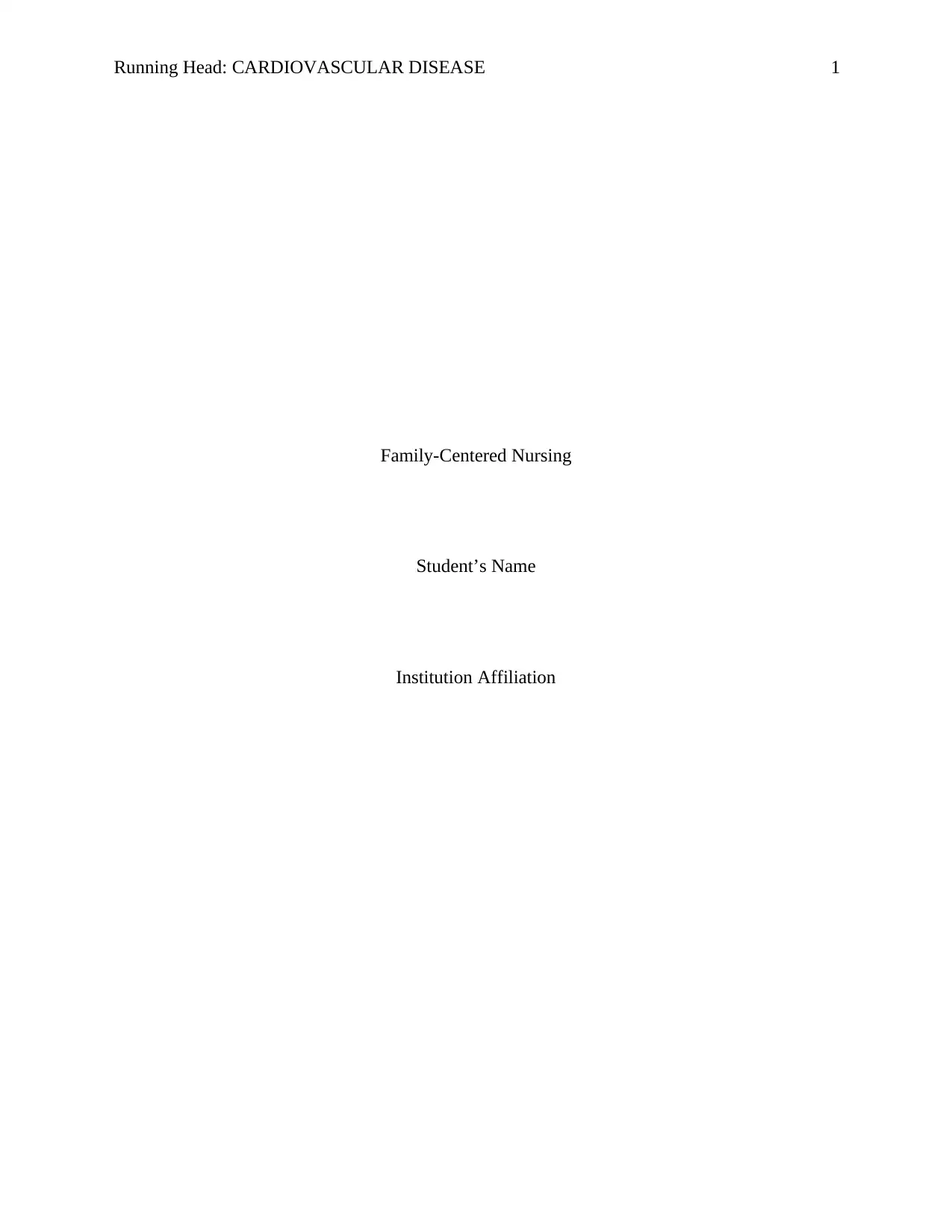
Running Head: CARDIOVASCULAR DISEASE 1
Family-Centered Nursing
Student’s Name
Institution Affiliation
Family-Centered Nursing
Student’s Name
Institution Affiliation
Secure Best Marks with AI Grader
Need help grading? Try our AI Grader for instant feedback on your assignments.
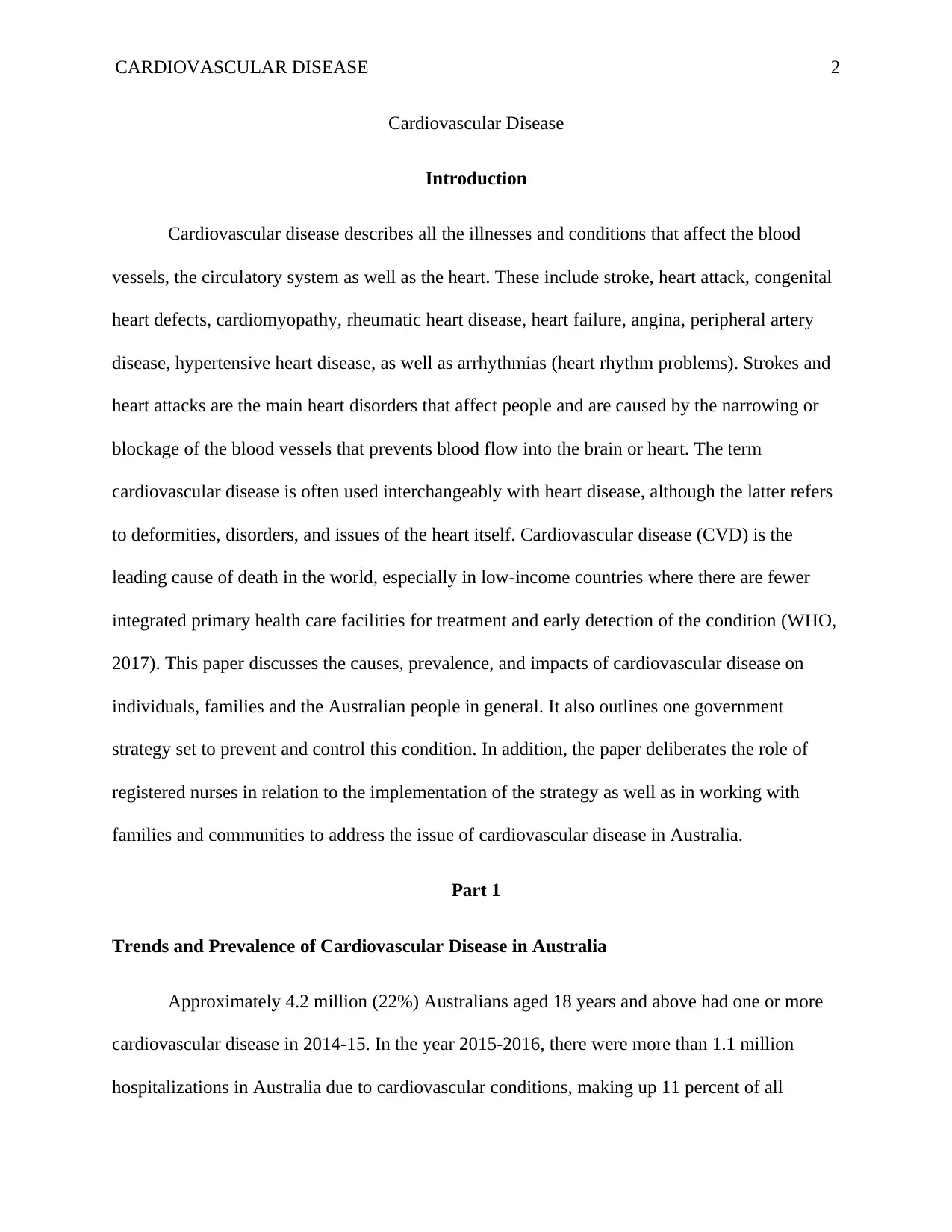
CARDIOVASCULAR DISEASE 2
Cardiovascular Disease
Introduction
Cardiovascular disease describes all the illnesses and conditions that affect the blood
vessels, the circulatory system as well as the heart. These include stroke, heart attack, congenital
heart defects, cardiomyopathy, rheumatic heart disease, heart failure, angina, peripheral artery
disease, hypertensive heart disease, as well as arrhythmias (heart rhythm problems). Strokes and
heart attacks are the main heart disorders that affect people and are caused by the narrowing or
blockage of the blood vessels that prevents blood flow into the brain or heart. The term
cardiovascular disease is often used interchangeably with heart disease, although the latter refers
to deformities, disorders, and issues of the heart itself. Cardiovascular disease (CVD) is the
leading cause of death in the world, especially in low-income countries where there are fewer
integrated primary health care facilities for treatment and early detection of the condition (WHO,
2017). This paper discusses the causes, prevalence, and impacts of cardiovascular disease on
individuals, families and the Australian people in general. It also outlines one government
strategy set to prevent and control this condition. In addition, the paper deliberates the role of
registered nurses in relation to the implementation of the strategy as well as in working with
families and communities to address the issue of cardiovascular disease in Australia.
Part 1
Trends and Prevalence of Cardiovascular Disease in Australia
Approximately 4.2 million (22%) Australians aged 18 years and above had one or more
cardiovascular disease in 2014-15. In the year 2015-2016, there were more than 1.1 million
hospitalizations in Australia due to cardiovascular conditions, making up 11 percent of all
Cardiovascular Disease
Introduction
Cardiovascular disease describes all the illnesses and conditions that affect the blood
vessels, the circulatory system as well as the heart. These include stroke, heart attack, congenital
heart defects, cardiomyopathy, rheumatic heart disease, heart failure, angina, peripheral artery
disease, hypertensive heart disease, as well as arrhythmias (heart rhythm problems). Strokes and
heart attacks are the main heart disorders that affect people and are caused by the narrowing or
blockage of the blood vessels that prevents blood flow into the brain or heart. The term
cardiovascular disease is often used interchangeably with heart disease, although the latter refers
to deformities, disorders, and issues of the heart itself. Cardiovascular disease (CVD) is the
leading cause of death in the world, especially in low-income countries where there are fewer
integrated primary health care facilities for treatment and early detection of the condition (WHO,
2017). This paper discusses the causes, prevalence, and impacts of cardiovascular disease on
individuals, families and the Australian people in general. It also outlines one government
strategy set to prevent and control this condition. In addition, the paper deliberates the role of
registered nurses in relation to the implementation of the strategy as well as in working with
families and communities to address the issue of cardiovascular disease in Australia.
Part 1
Trends and Prevalence of Cardiovascular Disease in Australia
Approximately 4.2 million (22%) Australians aged 18 years and above had one or more
cardiovascular disease in 2014-15. In the year 2015-2016, there were more than 1.1 million
hospitalizations in Australia due to cardiovascular conditions, making up 11 percent of all
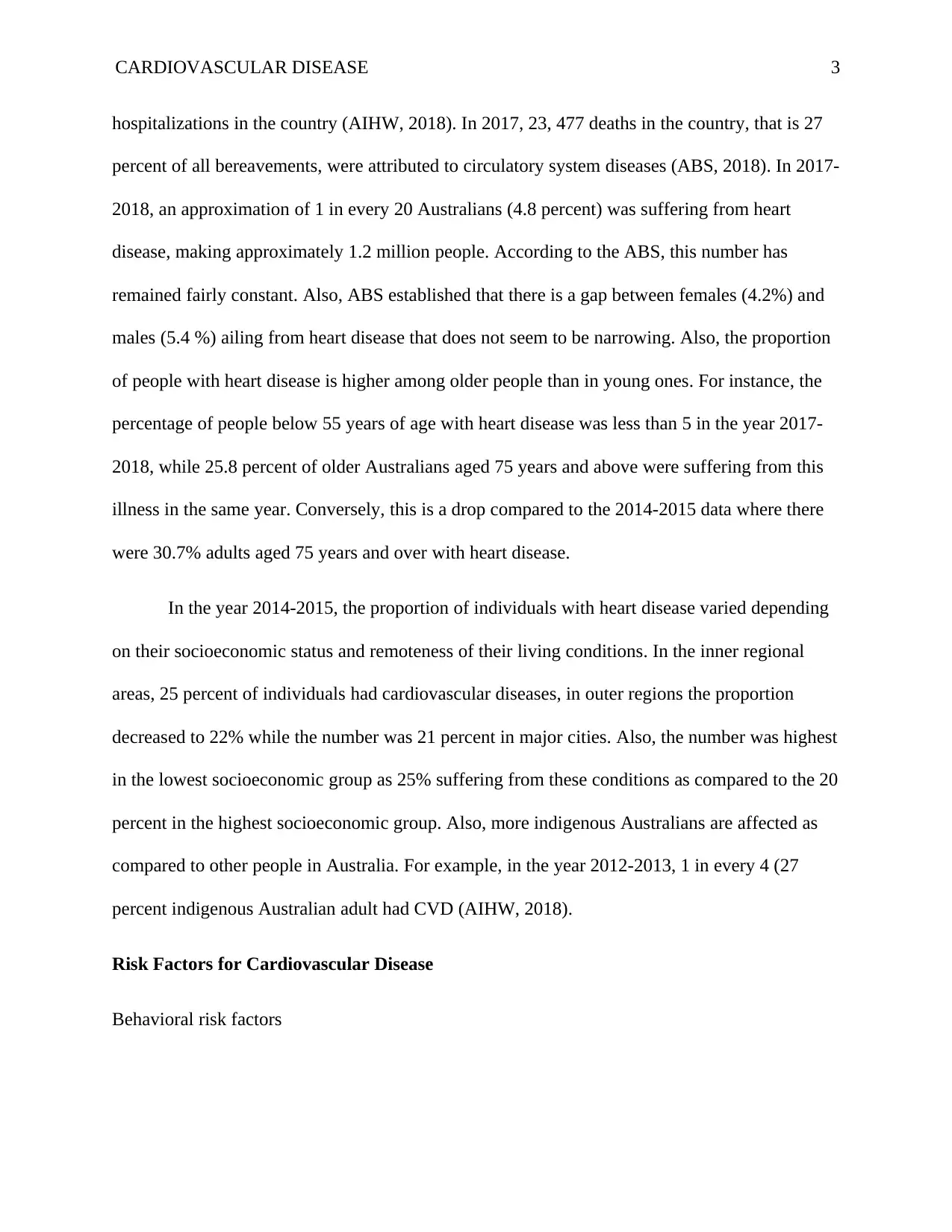
CARDIOVASCULAR DISEASE 3
hospitalizations in the country (AIHW, 2018). In 2017, 23, 477 deaths in the country, that is 27
percent of all bereavements, were attributed to circulatory system diseases (ABS, 2018). In 2017-
2018, an approximation of 1 in every 20 Australians (4.8 percent) was suffering from heart
disease, making approximately 1.2 million people. According to the ABS, this number has
remained fairly constant. Also, ABS established that there is a gap between females (4.2%) and
males (5.4 %) ailing from heart disease that does not seem to be narrowing. Also, the proportion
of people with heart disease is higher among older people than in young ones. For instance, the
percentage of people below 55 years of age with heart disease was less than 5 in the year 2017-
2018, while 25.8 percent of older Australians aged 75 years and above were suffering from this
illness in the same year. Conversely, this is a drop compared to the 2014-2015 data where there
were 30.7% adults aged 75 years and over with heart disease.
In the year 2014-2015, the proportion of individuals with heart disease varied depending
on their socioeconomic status and remoteness of their living conditions. In the inner regional
areas, 25 percent of individuals had cardiovascular diseases, in outer regions the proportion
decreased to 22% while the number was 21 percent in major cities. Also, the number was highest
in the lowest socioeconomic group as 25% suffering from these conditions as compared to the 20
percent in the highest socioeconomic group. Also, more indigenous Australians are affected as
compared to other people in Australia. For example, in the year 2012-2013, 1 in every 4 (27
percent indigenous Australian adult had CVD (AIHW, 2018).
Risk Factors for Cardiovascular Disease
Behavioral risk factors
hospitalizations in the country (AIHW, 2018). In 2017, 23, 477 deaths in the country, that is 27
percent of all bereavements, were attributed to circulatory system diseases (ABS, 2018). In 2017-
2018, an approximation of 1 in every 20 Australians (4.8 percent) was suffering from heart
disease, making approximately 1.2 million people. According to the ABS, this number has
remained fairly constant. Also, ABS established that there is a gap between females (4.2%) and
males (5.4 %) ailing from heart disease that does not seem to be narrowing. Also, the proportion
of people with heart disease is higher among older people than in young ones. For instance, the
percentage of people below 55 years of age with heart disease was less than 5 in the year 2017-
2018, while 25.8 percent of older Australians aged 75 years and above were suffering from this
illness in the same year. Conversely, this is a drop compared to the 2014-2015 data where there
were 30.7% adults aged 75 years and over with heart disease.
In the year 2014-2015, the proportion of individuals with heart disease varied depending
on their socioeconomic status and remoteness of their living conditions. In the inner regional
areas, 25 percent of individuals had cardiovascular diseases, in outer regions the proportion
decreased to 22% while the number was 21 percent in major cities. Also, the number was highest
in the lowest socioeconomic group as 25% suffering from these conditions as compared to the 20
percent in the highest socioeconomic group. Also, more indigenous Australians are affected as
compared to other people in Australia. For example, in the year 2012-2013, 1 in every 4 (27
percent indigenous Australian adult had CVD (AIHW, 2018).
Risk Factors for Cardiovascular Disease
Behavioral risk factors
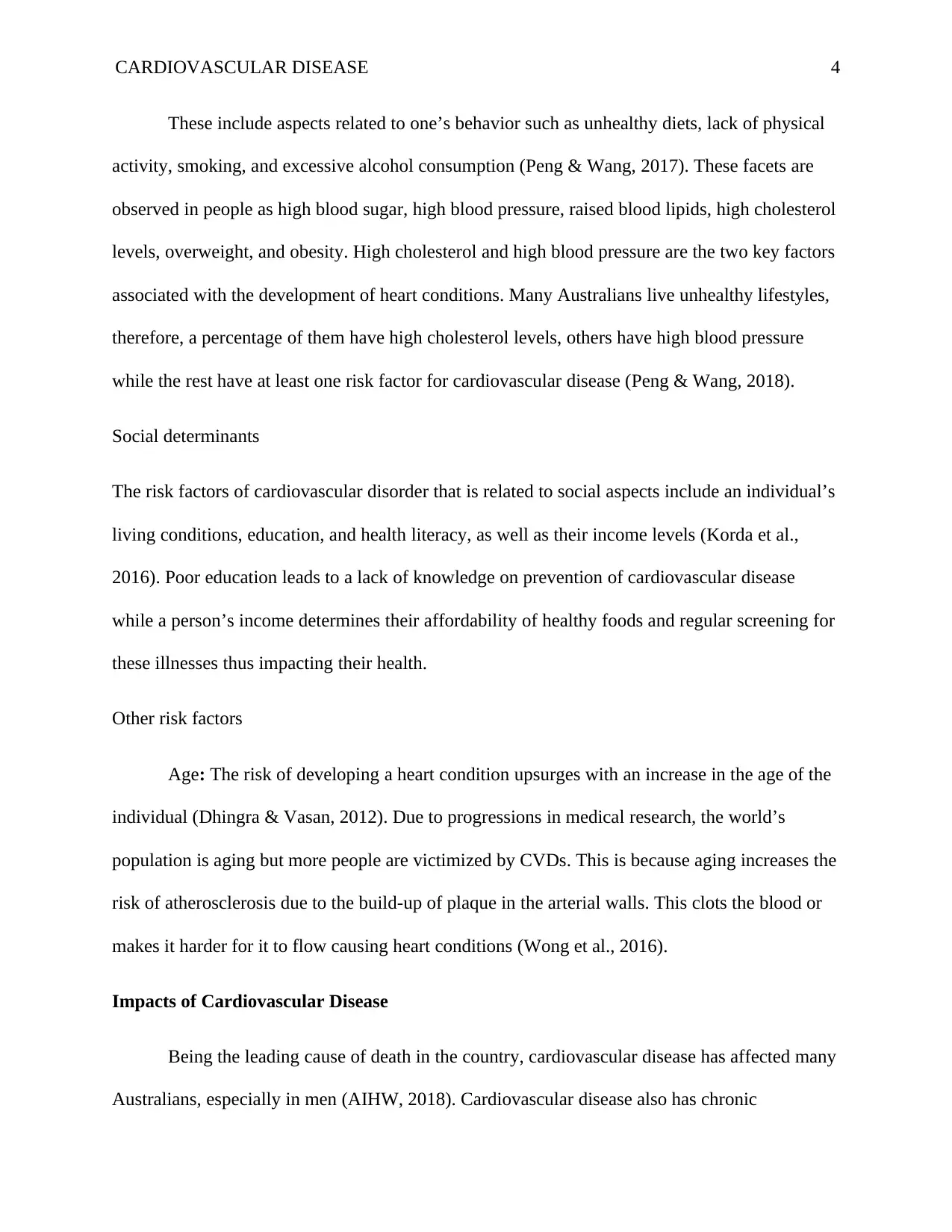
CARDIOVASCULAR DISEASE 4
These include aspects related to one’s behavior such as unhealthy diets, lack of physical
activity, smoking, and excessive alcohol consumption (Peng & Wang, 2017). These facets are
observed in people as high blood sugar, high blood pressure, raised blood lipids, high cholesterol
levels, overweight, and obesity. High cholesterol and high blood pressure are the two key factors
associated with the development of heart conditions. Many Australians live unhealthy lifestyles,
therefore, a percentage of them have high cholesterol levels, others have high blood pressure
while the rest have at least one risk factor for cardiovascular disease (Peng & Wang, 2018).
Social determinants
The risk factors of cardiovascular disorder that is related to social aspects include an individual’s
living conditions, education, and health literacy, as well as their income levels (Korda et al.,
2016). Poor education leads to a lack of knowledge on prevention of cardiovascular disease
while a person’s income determines their affordability of healthy foods and regular screening for
these illnesses thus impacting their health.
Other risk factors
Age: The risk of developing a heart condition upsurges with an increase in the age of the
individual (Dhingra & Vasan, 2012). Due to progressions in medical research, the world’s
population is aging but more people are victimized by CVDs. This is because aging increases the
risk of atherosclerosis due to the build-up of plaque in the arterial walls. This clots the blood or
makes it harder for it to flow causing heart conditions (Wong et al., 2016).
Impacts of Cardiovascular Disease
Being the leading cause of death in the country, cardiovascular disease has affected many
Australians, especially in men (AIHW, 2018). Cardiovascular disease also has chronic
These include aspects related to one’s behavior such as unhealthy diets, lack of physical
activity, smoking, and excessive alcohol consumption (Peng & Wang, 2017). These facets are
observed in people as high blood sugar, high blood pressure, raised blood lipids, high cholesterol
levels, overweight, and obesity. High cholesterol and high blood pressure are the two key factors
associated with the development of heart conditions. Many Australians live unhealthy lifestyles,
therefore, a percentage of them have high cholesterol levels, others have high blood pressure
while the rest have at least one risk factor for cardiovascular disease (Peng & Wang, 2018).
Social determinants
The risk factors of cardiovascular disorder that is related to social aspects include an individual’s
living conditions, education, and health literacy, as well as their income levels (Korda et al.,
2016). Poor education leads to a lack of knowledge on prevention of cardiovascular disease
while a person’s income determines their affordability of healthy foods and regular screening for
these illnesses thus impacting their health.
Other risk factors
Age: The risk of developing a heart condition upsurges with an increase in the age of the
individual (Dhingra & Vasan, 2012). Due to progressions in medical research, the world’s
population is aging but more people are victimized by CVDs. This is because aging increases the
risk of atherosclerosis due to the build-up of plaque in the arterial walls. This clots the blood or
makes it harder for it to flow causing heart conditions (Wong et al., 2016).
Impacts of Cardiovascular Disease
Being the leading cause of death in the country, cardiovascular disease has affected many
Australians, especially in men (AIHW, 2018). Cardiovascular disease also has chronic
Secure Best Marks with AI Grader
Need help grading? Try our AI Grader for instant feedback on your assignments.
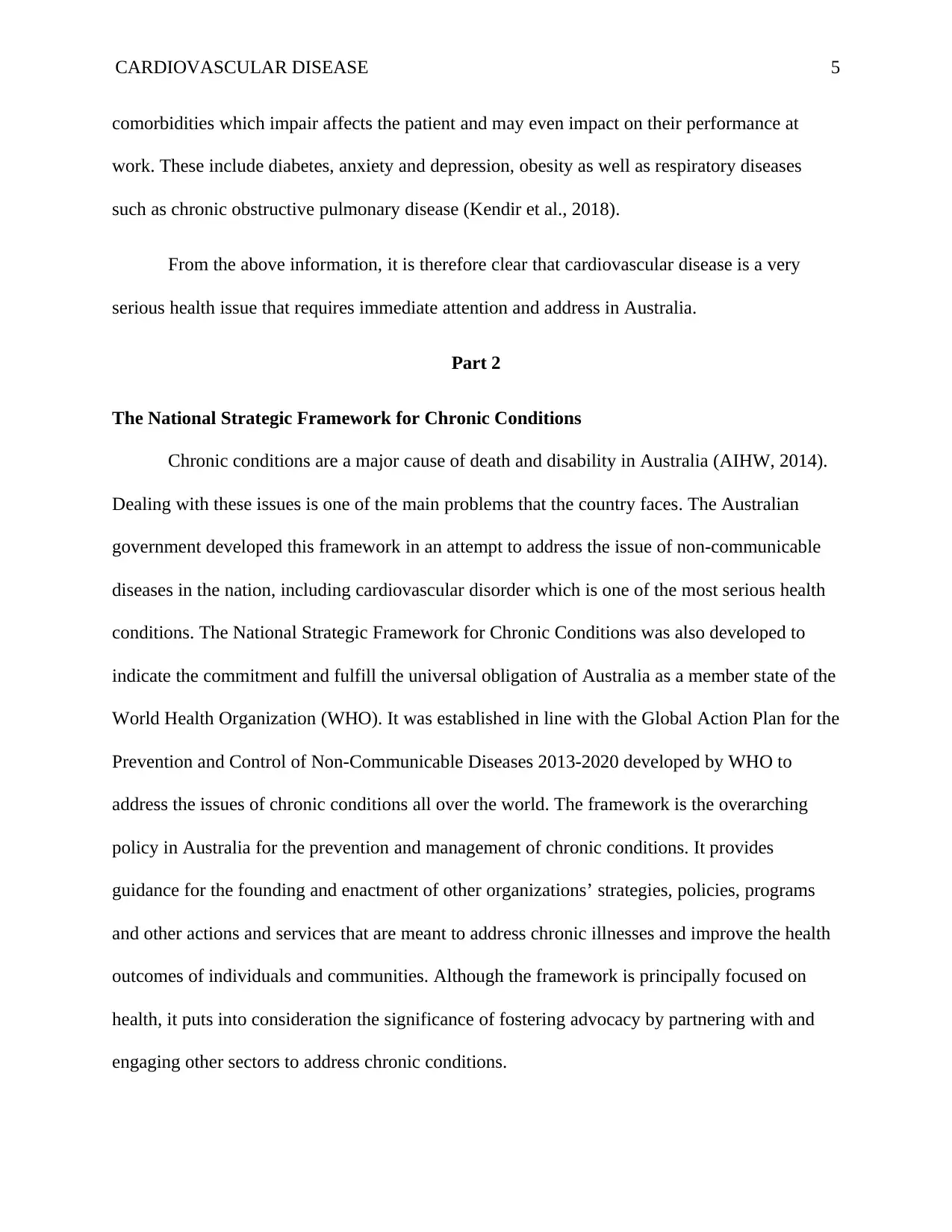
CARDIOVASCULAR DISEASE 5
comorbidities which impair affects the patient and may even impact on their performance at
work. These include diabetes, anxiety and depression, obesity as well as respiratory diseases
such as chronic obstructive pulmonary disease (Kendir et al., 2018).
From the above information, it is therefore clear that cardiovascular disease is a very
serious health issue that requires immediate attention and address in Australia.
Part 2
The National Strategic Framework for Chronic Conditions
Chronic conditions are a major cause of death and disability in Australia (AIHW, 2014).
Dealing with these issues is one of the main problems that the country faces. The Australian
government developed this framework in an attempt to address the issue of non-communicable
diseases in the nation, including cardiovascular disorder which is one of the most serious health
conditions. The National Strategic Framework for Chronic Conditions was also developed to
indicate the commitment and fulfill the universal obligation of Australia as a member state of the
World Health Organization (WHO). It was established in line with the Global Action Plan for the
Prevention and Control of Non-Communicable Diseases 2013-2020 developed by WHO to
address the issues of chronic conditions all over the world. The framework is the overarching
policy in Australia for the prevention and management of chronic conditions. It provides
guidance for the founding and enactment of other organizations’ strategies, policies, programs
and other actions and services that are meant to address chronic illnesses and improve the health
outcomes of individuals and communities. Although the framework is principally focused on
health, it puts into consideration the significance of fostering advocacy by partnering with and
engaging other sectors to address chronic conditions.
comorbidities which impair affects the patient and may even impact on their performance at
work. These include diabetes, anxiety and depression, obesity as well as respiratory diseases
such as chronic obstructive pulmonary disease (Kendir et al., 2018).
From the above information, it is therefore clear that cardiovascular disease is a very
serious health issue that requires immediate attention and address in Australia.
Part 2
The National Strategic Framework for Chronic Conditions
Chronic conditions are a major cause of death and disability in Australia (AIHW, 2014).
Dealing with these issues is one of the main problems that the country faces. The Australian
government developed this framework in an attempt to address the issue of non-communicable
diseases in the nation, including cardiovascular disorder which is one of the most serious health
conditions. The National Strategic Framework for Chronic Conditions was also developed to
indicate the commitment and fulfill the universal obligation of Australia as a member state of the
World Health Organization (WHO). It was established in line with the Global Action Plan for the
Prevention and Control of Non-Communicable Diseases 2013-2020 developed by WHO to
address the issues of chronic conditions all over the world. The framework is the overarching
policy in Australia for the prevention and management of chronic conditions. It provides
guidance for the founding and enactment of other organizations’ strategies, policies, programs
and other actions and services that are meant to address chronic illnesses and improve the health
outcomes of individuals and communities. Although the framework is principally focused on
health, it puts into consideration the significance of fostering advocacy by partnering with and
engaging other sectors to address chronic conditions.
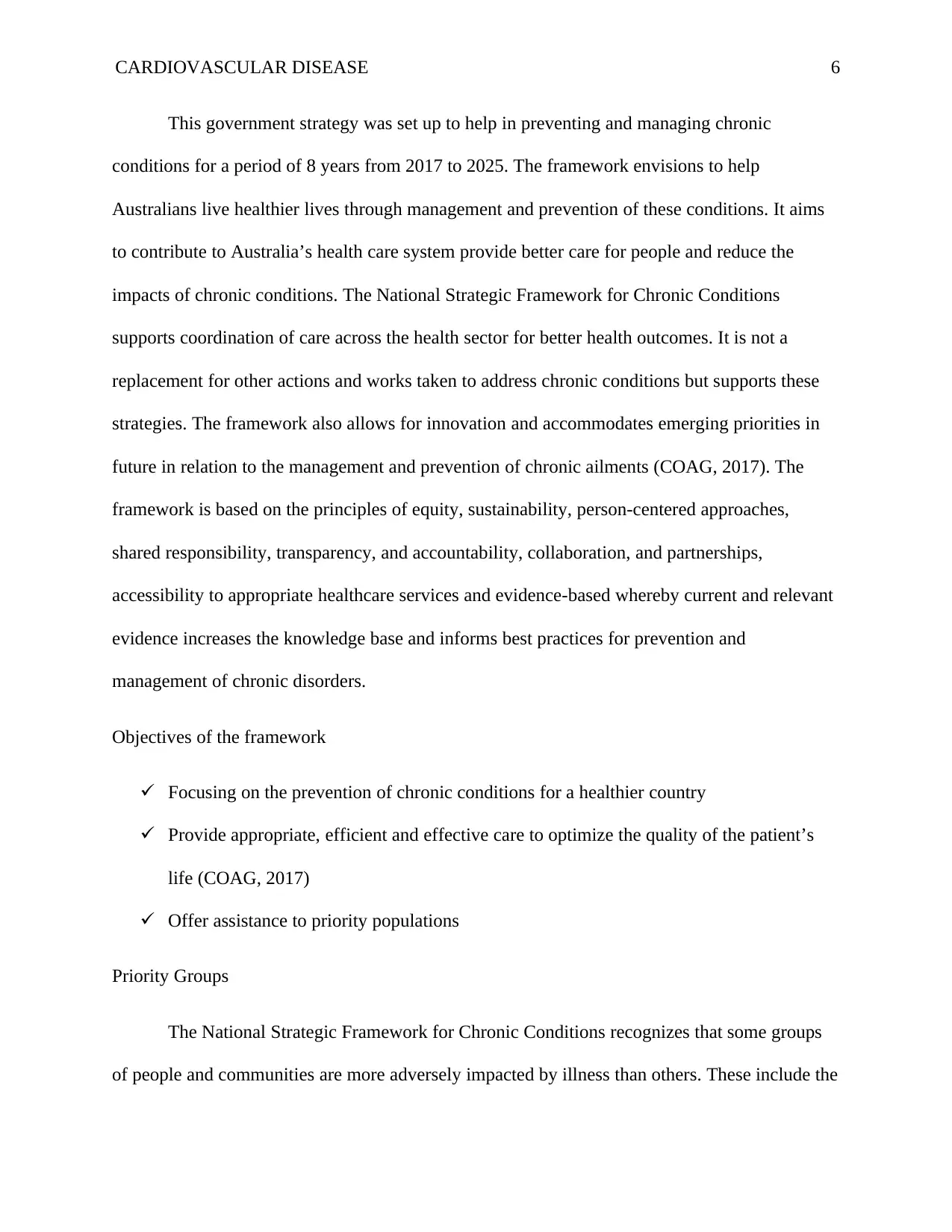
CARDIOVASCULAR DISEASE 6
This government strategy was set up to help in preventing and managing chronic
conditions for a period of 8 years from 2017 to 2025. The framework envisions to help
Australians live healthier lives through management and prevention of these conditions. It aims
to contribute to Australia’s health care system provide better care for people and reduce the
impacts of chronic conditions. The National Strategic Framework for Chronic Conditions
supports coordination of care across the health sector for better health outcomes. It is not a
replacement for other actions and works taken to address chronic conditions but supports these
strategies. The framework also allows for innovation and accommodates emerging priorities in
future in relation to the management and prevention of chronic ailments (COAG, 2017). The
framework is based on the principles of equity, sustainability, person-centered approaches,
shared responsibility, transparency, and accountability, collaboration, and partnerships,
accessibility to appropriate healthcare services and evidence-based whereby current and relevant
evidence increases the knowledge base and informs best practices for prevention and
management of chronic disorders.
Objectives of the framework
Focusing on the prevention of chronic conditions for a healthier country
Provide appropriate, efficient and effective care to optimize the quality of the patient’s
life (COAG, 2017)
Offer assistance to priority populations
Priority Groups
The National Strategic Framework for Chronic Conditions recognizes that some groups
of people and communities are more adversely impacted by illness than others. These include the
This government strategy was set up to help in preventing and managing chronic
conditions for a period of 8 years from 2017 to 2025. The framework envisions to help
Australians live healthier lives through management and prevention of these conditions. It aims
to contribute to Australia’s health care system provide better care for people and reduce the
impacts of chronic conditions. The National Strategic Framework for Chronic Conditions
supports coordination of care across the health sector for better health outcomes. It is not a
replacement for other actions and works taken to address chronic conditions but supports these
strategies. The framework also allows for innovation and accommodates emerging priorities in
future in relation to the management and prevention of chronic ailments (COAG, 2017). The
framework is based on the principles of equity, sustainability, person-centered approaches,
shared responsibility, transparency, and accountability, collaboration, and partnerships,
accessibility to appropriate healthcare services and evidence-based whereby current and relevant
evidence increases the knowledge base and informs best practices for prevention and
management of chronic disorders.
Objectives of the framework
Focusing on the prevention of chronic conditions for a healthier country
Provide appropriate, efficient and effective care to optimize the quality of the patient’s
life (COAG, 2017)
Offer assistance to priority populations
Priority Groups
The National Strategic Framework for Chronic Conditions recognizes that some groups
of people and communities are more adversely impacted by illness than others. These include the
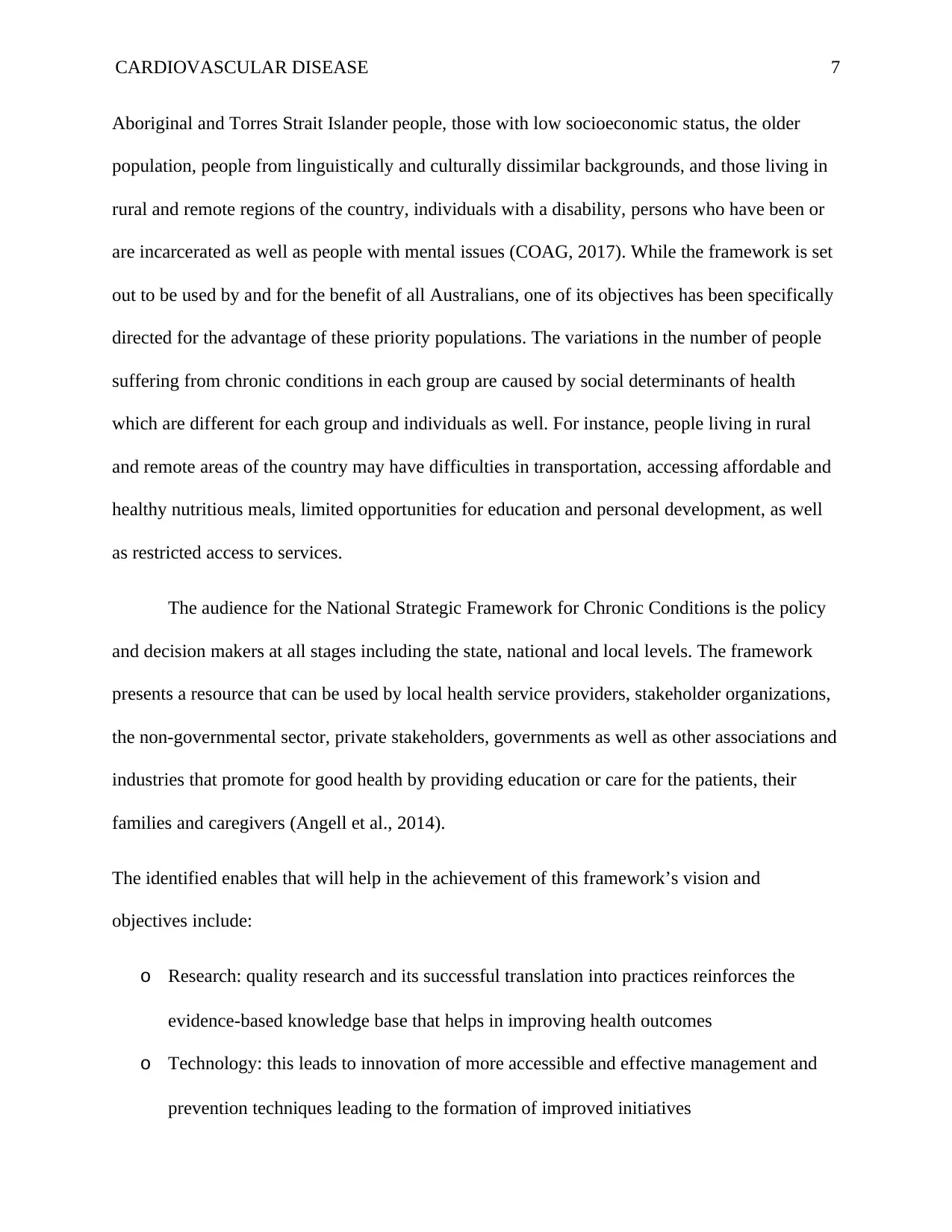
CARDIOVASCULAR DISEASE 7
Aboriginal and Torres Strait Islander people, those with low socioeconomic status, the older
population, people from linguistically and culturally dissimilar backgrounds, and those living in
rural and remote regions of the country, individuals with a disability, persons who have been or
are incarcerated as well as people with mental issues (COAG, 2017). While the framework is set
out to be used by and for the benefit of all Australians, one of its objectives has been specifically
directed for the advantage of these priority populations. The variations in the number of people
suffering from chronic conditions in each group are caused by social determinants of health
which are different for each group and individuals as well. For instance, people living in rural
and remote areas of the country may have difficulties in transportation, accessing affordable and
healthy nutritious meals, limited opportunities for education and personal development, as well
as restricted access to services.
The audience for the National Strategic Framework for Chronic Conditions is the policy
and decision makers at all stages including the state, national and local levels. The framework
presents a resource that can be used by local health service providers, stakeholder organizations,
the non-governmental sector, private stakeholders, governments as well as other associations and
industries that promote for good health by providing education or care for the patients, their
families and caregivers (Angell et al., 2014).
The identified enables that will help in the achievement of this framework’s vision and
objectives include:
o Research: quality research and its successful translation into practices reinforces the
evidence-based knowledge base that helps in improving health outcomes
o Technology: this leads to innovation of more accessible and effective management and
prevention techniques leading to the formation of improved initiatives
Aboriginal and Torres Strait Islander people, those with low socioeconomic status, the older
population, people from linguistically and culturally dissimilar backgrounds, and those living in
rural and remote regions of the country, individuals with a disability, persons who have been or
are incarcerated as well as people with mental issues (COAG, 2017). While the framework is set
out to be used by and for the benefit of all Australians, one of its objectives has been specifically
directed for the advantage of these priority populations. The variations in the number of people
suffering from chronic conditions in each group are caused by social determinants of health
which are different for each group and individuals as well. For instance, people living in rural
and remote areas of the country may have difficulties in transportation, accessing affordable and
healthy nutritious meals, limited opportunities for education and personal development, as well
as restricted access to services.
The audience for the National Strategic Framework for Chronic Conditions is the policy
and decision makers at all stages including the state, national and local levels. The framework
presents a resource that can be used by local health service providers, stakeholder organizations,
the non-governmental sector, private stakeholders, governments as well as other associations and
industries that promote for good health by providing education or care for the patients, their
families and caregivers (Angell et al., 2014).
The identified enables that will help in the achievement of this framework’s vision and
objectives include:
o Research: quality research and its successful translation into practices reinforces the
evidence-based knowledge base that helps in improving health outcomes
o Technology: this leads to innovation of more accessible and effective management and
prevention techniques leading to the formation of improved initiatives
Paraphrase This Document
Need a fresh take? Get an instant paraphrase of this document with our AI Paraphraser
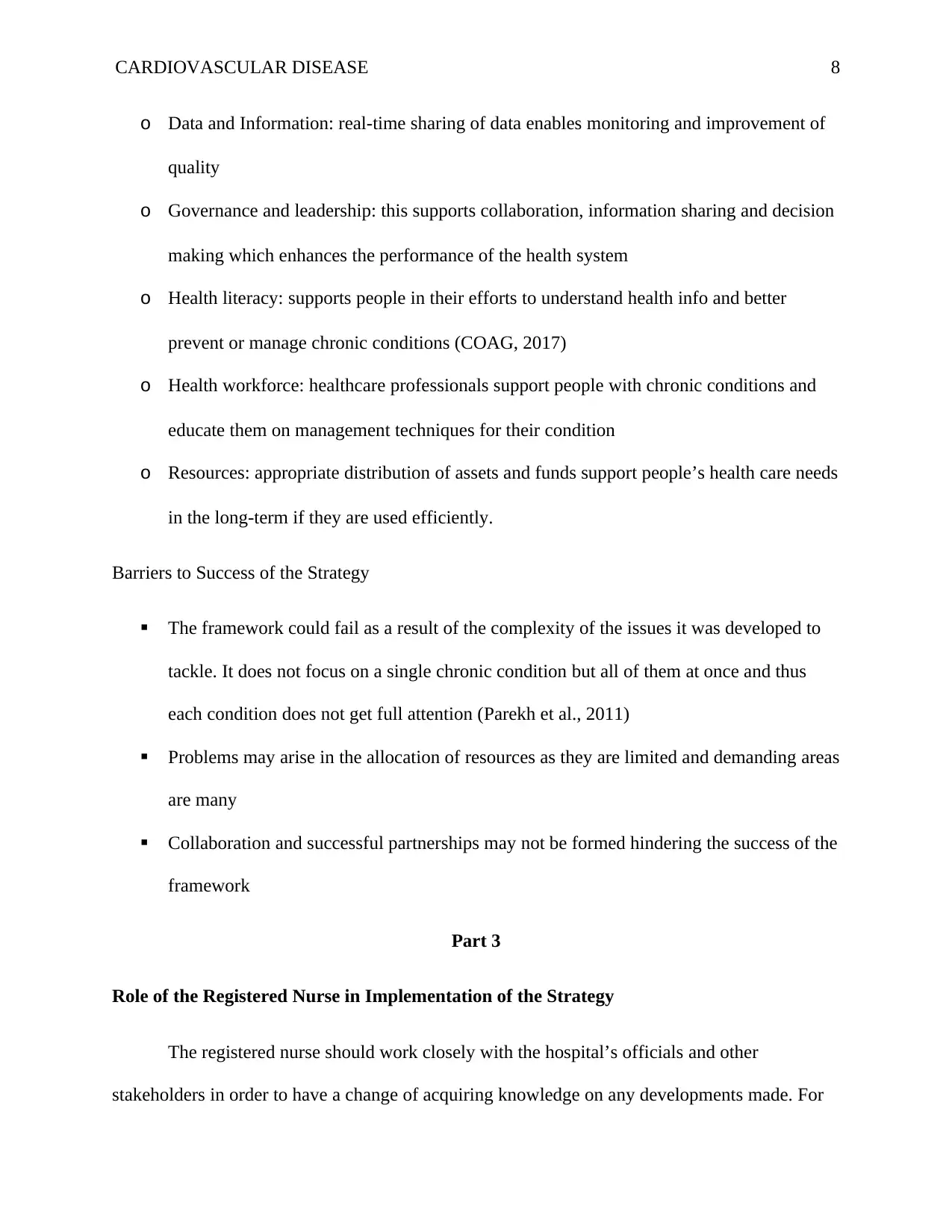
CARDIOVASCULAR DISEASE 8
o Data and Information: real-time sharing of data enables monitoring and improvement of
quality
o Governance and leadership: this supports collaboration, information sharing and decision
making which enhances the performance of the health system
o Health literacy: supports people in their efforts to understand health info and better
prevent or manage chronic conditions (COAG, 2017)
o Health workforce: healthcare professionals support people with chronic conditions and
educate them on management techniques for their condition
o Resources: appropriate distribution of assets and funds support people’s health care needs
in the long-term if they are used efficiently.
Barriers to Success of the Strategy
The framework could fail as a result of the complexity of the issues it was developed to
tackle. It does not focus on a single chronic condition but all of them at once and thus
each condition does not get full attention (Parekh et al., 2011)
Problems may arise in the allocation of resources as they are limited and demanding areas
are many
Collaboration and successful partnerships may not be formed hindering the success of the
framework
Part 3
Role of the Registered Nurse in Implementation of the Strategy
The registered nurse should work closely with the hospital’s officials and other
stakeholders in order to have a change of acquiring knowledge on any developments made. For
o Data and Information: real-time sharing of data enables monitoring and improvement of
quality
o Governance and leadership: this supports collaboration, information sharing and decision
making which enhances the performance of the health system
o Health literacy: supports people in their efforts to understand health info and better
prevent or manage chronic conditions (COAG, 2017)
o Health workforce: healthcare professionals support people with chronic conditions and
educate them on management techniques for their condition
o Resources: appropriate distribution of assets and funds support people’s health care needs
in the long-term if they are used efficiently.
Barriers to Success of the Strategy
The framework could fail as a result of the complexity of the issues it was developed to
tackle. It does not focus on a single chronic condition but all of them at once and thus
each condition does not get full attention (Parekh et al., 2011)
Problems may arise in the allocation of resources as they are limited and demanding areas
are many
Collaboration and successful partnerships may not be formed hindering the success of the
framework
Part 3
Role of the Registered Nurse in Implementation of the Strategy
The registered nurse should work closely with the hospital’s officials and other
stakeholders in order to have a change of acquiring knowledge on any developments made. For
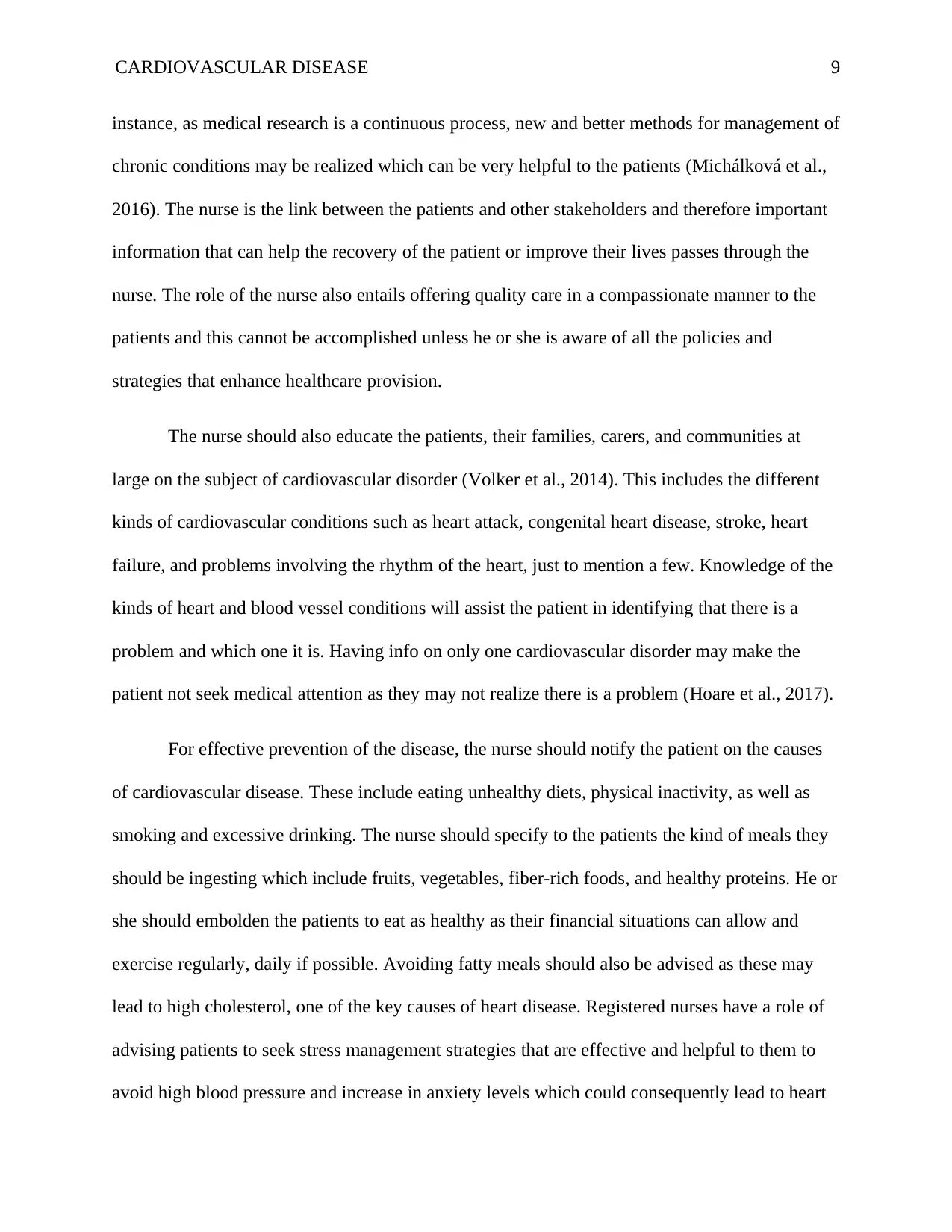
CARDIOVASCULAR DISEASE 9
instance, as medical research is a continuous process, new and better methods for management of
chronic conditions may be realized which can be very helpful to the patients (Michálková et al.,
2016). The nurse is the link between the patients and other stakeholders and therefore important
information that can help the recovery of the patient or improve their lives passes through the
nurse. The role of the nurse also entails offering quality care in a compassionate manner to the
patients and this cannot be accomplished unless he or she is aware of all the policies and
strategies that enhance healthcare provision.
The nurse should also educate the patients, their families, carers, and communities at
large on the subject of cardiovascular disorder (Volker et al., 2014). This includes the different
kinds of cardiovascular conditions such as heart attack, congenital heart disease, stroke, heart
failure, and problems involving the rhythm of the heart, just to mention a few. Knowledge of the
kinds of heart and blood vessel conditions will assist the patient in identifying that there is a
problem and which one it is. Having info on only one cardiovascular disorder may make the
patient not seek medical attention as they may not realize there is a problem (Hoare et al., 2017).
For effective prevention of the disease, the nurse should notify the patient on the causes
of cardiovascular disease. These include eating unhealthy diets, physical inactivity, as well as
smoking and excessive drinking. The nurse should specify to the patients the kind of meals they
should be ingesting which include fruits, vegetables, fiber-rich foods, and healthy proteins. He or
she should embolden the patients to eat as healthy as their financial situations can allow and
exercise regularly, daily if possible. Avoiding fatty meals should also be advised as these may
lead to high cholesterol, one of the key causes of heart disease. Registered nurses have a role of
advising patients to seek stress management strategies that are effective and helpful to them to
avoid high blood pressure and increase in anxiety levels which could consequently lead to heart
instance, as medical research is a continuous process, new and better methods for management of
chronic conditions may be realized which can be very helpful to the patients (Michálková et al.,
2016). The nurse is the link between the patients and other stakeholders and therefore important
information that can help the recovery of the patient or improve their lives passes through the
nurse. The role of the nurse also entails offering quality care in a compassionate manner to the
patients and this cannot be accomplished unless he or she is aware of all the policies and
strategies that enhance healthcare provision.
The nurse should also educate the patients, their families, carers, and communities at
large on the subject of cardiovascular disorder (Volker et al., 2014). This includes the different
kinds of cardiovascular conditions such as heart attack, congenital heart disease, stroke, heart
failure, and problems involving the rhythm of the heart, just to mention a few. Knowledge of the
kinds of heart and blood vessel conditions will assist the patient in identifying that there is a
problem and which one it is. Having info on only one cardiovascular disorder may make the
patient not seek medical attention as they may not realize there is a problem (Hoare et al., 2017).
For effective prevention of the disease, the nurse should notify the patient on the causes
of cardiovascular disease. These include eating unhealthy diets, physical inactivity, as well as
smoking and excessive drinking. The nurse should specify to the patients the kind of meals they
should be ingesting which include fruits, vegetables, fiber-rich foods, and healthy proteins. He or
she should embolden the patients to eat as healthy as their financial situations can allow and
exercise regularly, daily if possible. Avoiding fatty meals should also be advised as these may
lead to high cholesterol, one of the key causes of heart disease. Registered nurses have a role of
advising patients to seek stress management strategies that are effective and helpful to them to
avoid high blood pressure and increase in anxiety levels which could consequently lead to heart
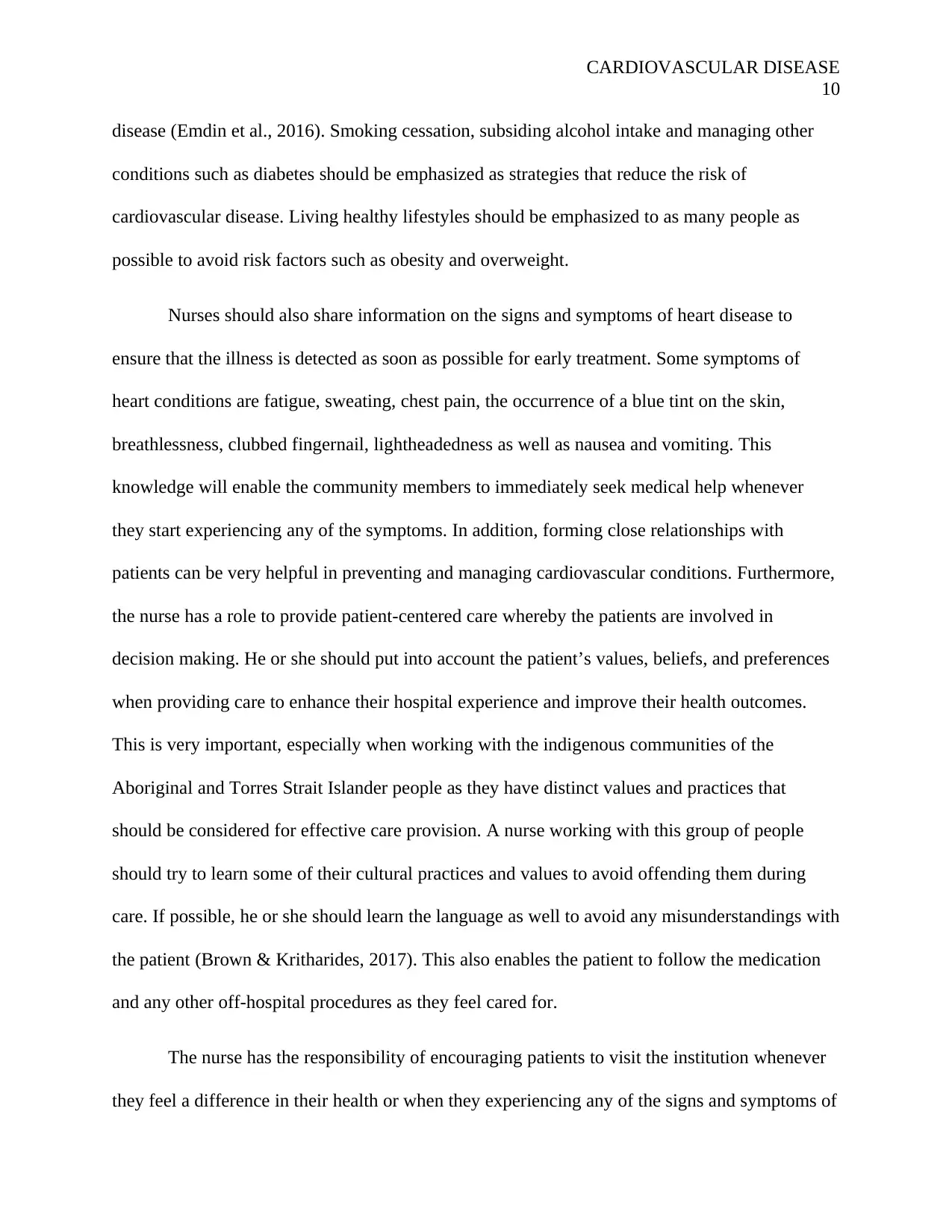
CARDIOVASCULAR DISEASE
10
disease (Emdin et al., 2016). Smoking cessation, subsiding alcohol intake and managing other
conditions such as diabetes should be emphasized as strategies that reduce the risk of
cardiovascular disease. Living healthy lifestyles should be emphasized to as many people as
possible to avoid risk factors such as obesity and overweight.
Nurses should also share information on the signs and symptoms of heart disease to
ensure that the illness is detected as soon as possible for early treatment. Some symptoms of
heart conditions are fatigue, sweating, chest pain, the occurrence of a blue tint on the skin,
breathlessness, clubbed fingernail, lightheadedness as well as nausea and vomiting. This
knowledge will enable the community members to immediately seek medical help whenever
they start experiencing any of the symptoms. In addition, forming close relationships with
patients can be very helpful in preventing and managing cardiovascular conditions. Furthermore,
the nurse has a role to provide patient-centered care whereby the patients are involved in
decision making. He or she should put into account the patient’s values, beliefs, and preferences
when providing care to enhance their hospital experience and improve their health outcomes.
This is very important, especially when working with the indigenous communities of the
Aboriginal and Torres Strait Islander people as they have distinct values and practices that
should be considered for effective care provision. A nurse working with this group of people
should try to learn some of their cultural practices and values to avoid offending them during
care. If possible, he or she should learn the language as well to avoid any misunderstandings with
the patient (Brown & Kritharides, 2017). This also enables the patient to follow the medication
and any other off-hospital procedures as they feel cared for.
The nurse has the responsibility of encouraging patients to visit the institution whenever
they feel a difference in their health or when they experiencing any of the signs and symptoms of
10
disease (Emdin et al., 2016). Smoking cessation, subsiding alcohol intake and managing other
conditions such as diabetes should be emphasized as strategies that reduce the risk of
cardiovascular disease. Living healthy lifestyles should be emphasized to as many people as
possible to avoid risk factors such as obesity and overweight.
Nurses should also share information on the signs and symptoms of heart disease to
ensure that the illness is detected as soon as possible for early treatment. Some symptoms of
heart conditions are fatigue, sweating, chest pain, the occurrence of a blue tint on the skin,
breathlessness, clubbed fingernail, lightheadedness as well as nausea and vomiting. This
knowledge will enable the community members to immediately seek medical help whenever
they start experiencing any of the symptoms. In addition, forming close relationships with
patients can be very helpful in preventing and managing cardiovascular conditions. Furthermore,
the nurse has a role to provide patient-centered care whereby the patients are involved in
decision making. He or she should put into account the patient’s values, beliefs, and preferences
when providing care to enhance their hospital experience and improve their health outcomes.
This is very important, especially when working with the indigenous communities of the
Aboriginal and Torres Strait Islander people as they have distinct values and practices that
should be considered for effective care provision. A nurse working with this group of people
should try to learn some of their cultural practices and values to avoid offending them during
care. If possible, he or she should learn the language as well to avoid any misunderstandings with
the patient (Brown & Kritharides, 2017). This also enables the patient to follow the medication
and any other off-hospital procedures as they feel cared for.
The nurse has the responsibility of encouraging patients to visit the institution whenever
they feel a difference in their health or when they experiencing any of the signs and symptoms of
Secure Best Marks with AI Grader
Need help grading? Try our AI Grader for instant feedback on your assignments.
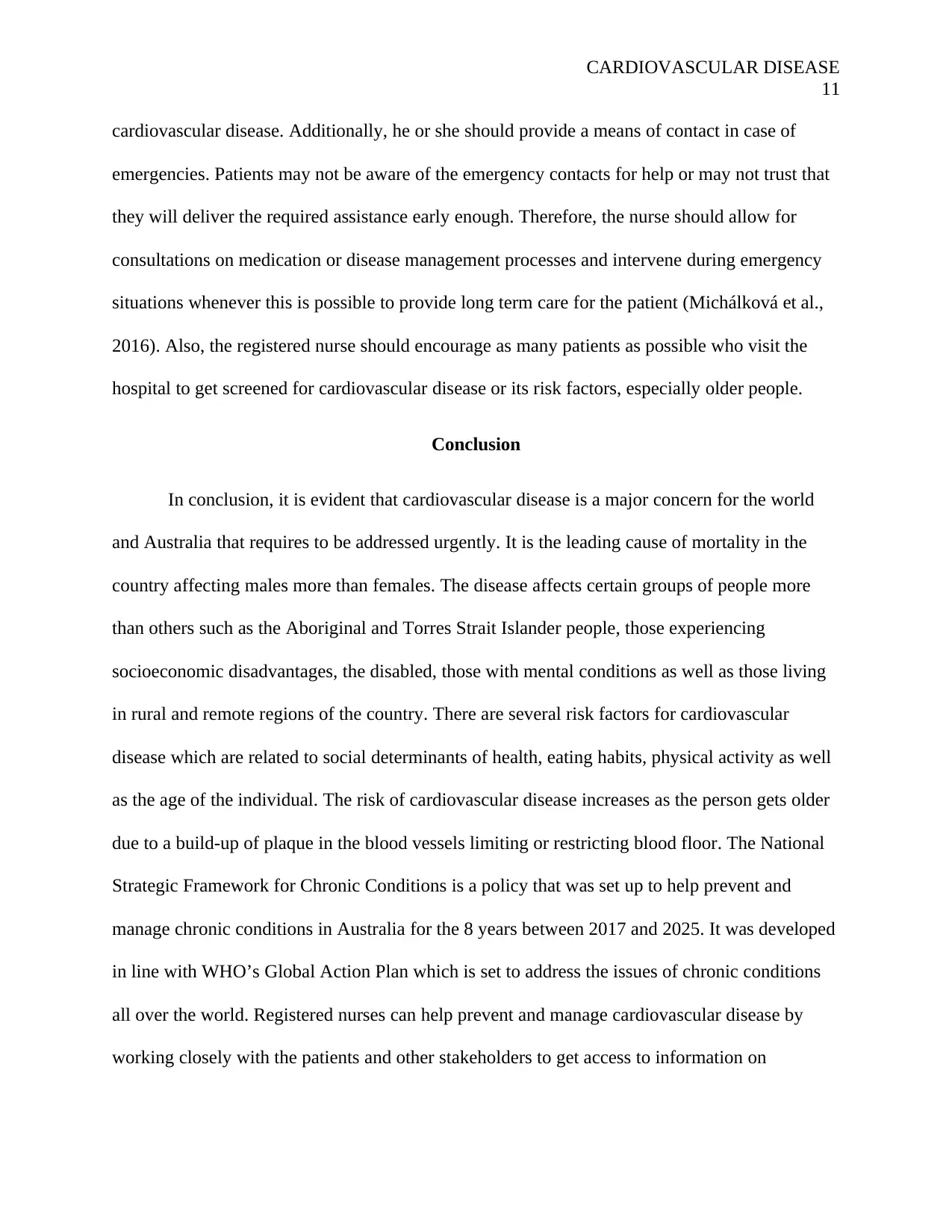
CARDIOVASCULAR DISEASE
11
cardiovascular disease. Additionally, he or she should provide a means of contact in case of
emergencies. Patients may not be aware of the emergency contacts for help or may not trust that
they will deliver the required assistance early enough. Therefore, the nurse should allow for
consultations on medication or disease management processes and intervene during emergency
situations whenever this is possible to provide long term care for the patient (Michálková et al.,
2016). Also, the registered nurse should encourage as many patients as possible who visit the
hospital to get screened for cardiovascular disease or its risk factors, especially older people.
Conclusion
In conclusion, it is evident that cardiovascular disease is a major concern for the world
and Australia that requires to be addressed urgently. It is the leading cause of mortality in the
country affecting males more than females. The disease affects certain groups of people more
than others such as the Aboriginal and Torres Strait Islander people, those experiencing
socioeconomic disadvantages, the disabled, those with mental conditions as well as those living
in rural and remote regions of the country. There are several risk factors for cardiovascular
disease which are related to social determinants of health, eating habits, physical activity as well
as the age of the individual. The risk of cardiovascular disease increases as the person gets older
due to a build-up of plaque in the blood vessels limiting or restricting blood floor. The National
Strategic Framework for Chronic Conditions is a policy that was set up to help prevent and
manage chronic conditions in Australia for the 8 years between 2017 and 2025. It was developed
in line with WHO’s Global Action Plan which is set to address the issues of chronic conditions
all over the world. Registered nurses can help prevent and manage cardiovascular disease by
working closely with the patients and other stakeholders to get access to information on
11
cardiovascular disease. Additionally, he or she should provide a means of contact in case of
emergencies. Patients may not be aware of the emergency contacts for help or may not trust that
they will deliver the required assistance early enough. Therefore, the nurse should allow for
consultations on medication or disease management processes and intervene during emergency
situations whenever this is possible to provide long term care for the patient (Michálková et al.,
2016). Also, the registered nurse should encourage as many patients as possible who visit the
hospital to get screened for cardiovascular disease or its risk factors, especially older people.
Conclusion
In conclusion, it is evident that cardiovascular disease is a major concern for the world
and Australia that requires to be addressed urgently. It is the leading cause of mortality in the
country affecting males more than females. The disease affects certain groups of people more
than others such as the Aboriginal and Torres Strait Islander people, those experiencing
socioeconomic disadvantages, the disabled, those with mental conditions as well as those living
in rural and remote regions of the country. There are several risk factors for cardiovascular
disease which are related to social determinants of health, eating habits, physical activity as well
as the age of the individual. The risk of cardiovascular disease increases as the person gets older
due to a build-up of plaque in the blood vessels limiting or restricting blood floor. The National
Strategic Framework for Chronic Conditions is a policy that was set up to help prevent and
manage chronic conditions in Australia for the 8 years between 2017 and 2025. It was developed
in line with WHO’s Global Action Plan which is set to address the issues of chronic conditions
all over the world. Registered nurses can help prevent and manage cardiovascular disease by
working closely with the patients and other stakeholders to get access to information on
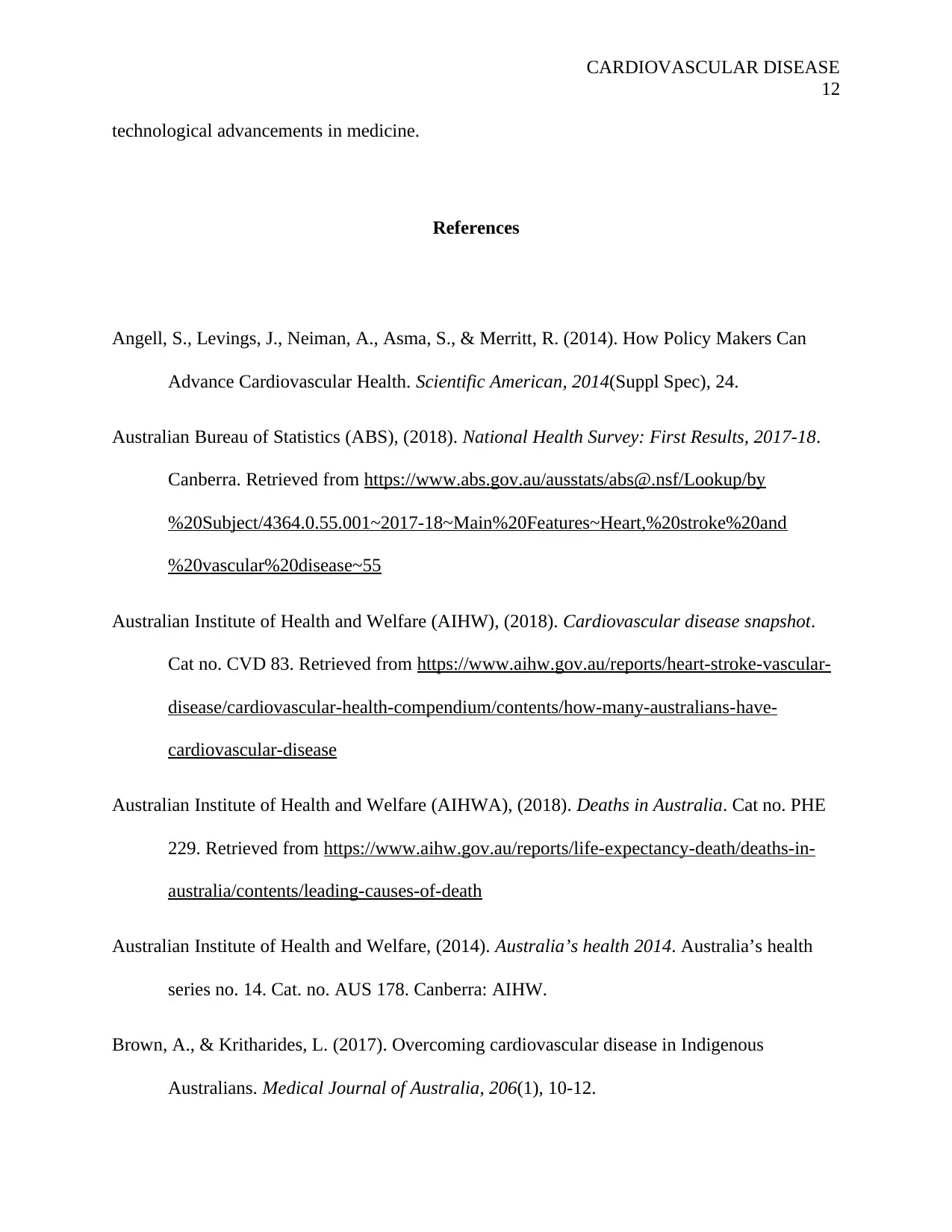
CARDIOVASCULAR DISEASE
12
technological advancements in medicine.
References
Angell, S., Levings, J., Neiman, A., Asma, S., & Merritt, R. (2014). How Policy Makers Can
Advance Cardiovascular Health. Scientific American, 2014(Suppl Spec), 24.
Australian Bureau of Statistics (ABS), (2018). National Health Survey: First Results, 2017-18.
Canberra. Retrieved from https://www.abs.gov.au/ausstats/abs@.nsf/Lookup/by
%20Subject/4364.0.55.001~2017-18~Main%20Features~Heart,%20stroke%20and
%20vascular%20disease~55
Australian Institute of Health and Welfare (AIHW), (2018). Cardiovascular disease snapshot.
Cat no. CVD 83. Retrieved from https://www.aihw.gov.au/reports/heart-stroke-vascular-
disease/cardiovascular-health-compendium/contents/how-many-australians-have-
cardiovascular-disease
Australian Institute of Health and Welfare (AIHWA), (2018). Deaths in Australia. Cat no. PHE
229. Retrieved from https://www.aihw.gov.au/reports/life-expectancy-death/deaths-in-
australia/contents/leading-causes-of-death
Australian Institute of Health and Welfare, (2014). Australia’s health 2014. Australia’s health
series no. 14. Cat. no. AUS 178. Canberra: AIHW.
Brown, A., & Kritharides, L. (2017). Overcoming cardiovascular disease in Indigenous
Australians. Medical Journal of Australia, 206(1), 10-12.
12
technological advancements in medicine.
References
Angell, S., Levings, J., Neiman, A., Asma, S., & Merritt, R. (2014). How Policy Makers Can
Advance Cardiovascular Health. Scientific American, 2014(Suppl Spec), 24.
Australian Bureau of Statistics (ABS), (2018). National Health Survey: First Results, 2017-18.
Canberra. Retrieved from https://www.abs.gov.au/ausstats/abs@.nsf/Lookup/by
%20Subject/4364.0.55.001~2017-18~Main%20Features~Heart,%20stroke%20and
%20vascular%20disease~55
Australian Institute of Health and Welfare (AIHW), (2018). Cardiovascular disease snapshot.
Cat no. CVD 83. Retrieved from https://www.aihw.gov.au/reports/heart-stroke-vascular-
disease/cardiovascular-health-compendium/contents/how-many-australians-have-
cardiovascular-disease
Australian Institute of Health and Welfare (AIHWA), (2018). Deaths in Australia. Cat no. PHE
229. Retrieved from https://www.aihw.gov.au/reports/life-expectancy-death/deaths-in-
australia/contents/leading-causes-of-death
Australian Institute of Health and Welfare, (2014). Australia’s health 2014. Australia’s health
series no. 14. Cat. no. AUS 178. Canberra: AIHW.
Brown, A., & Kritharides, L. (2017). Overcoming cardiovascular disease in Indigenous
Australians. Medical Journal of Australia, 206(1), 10-12.
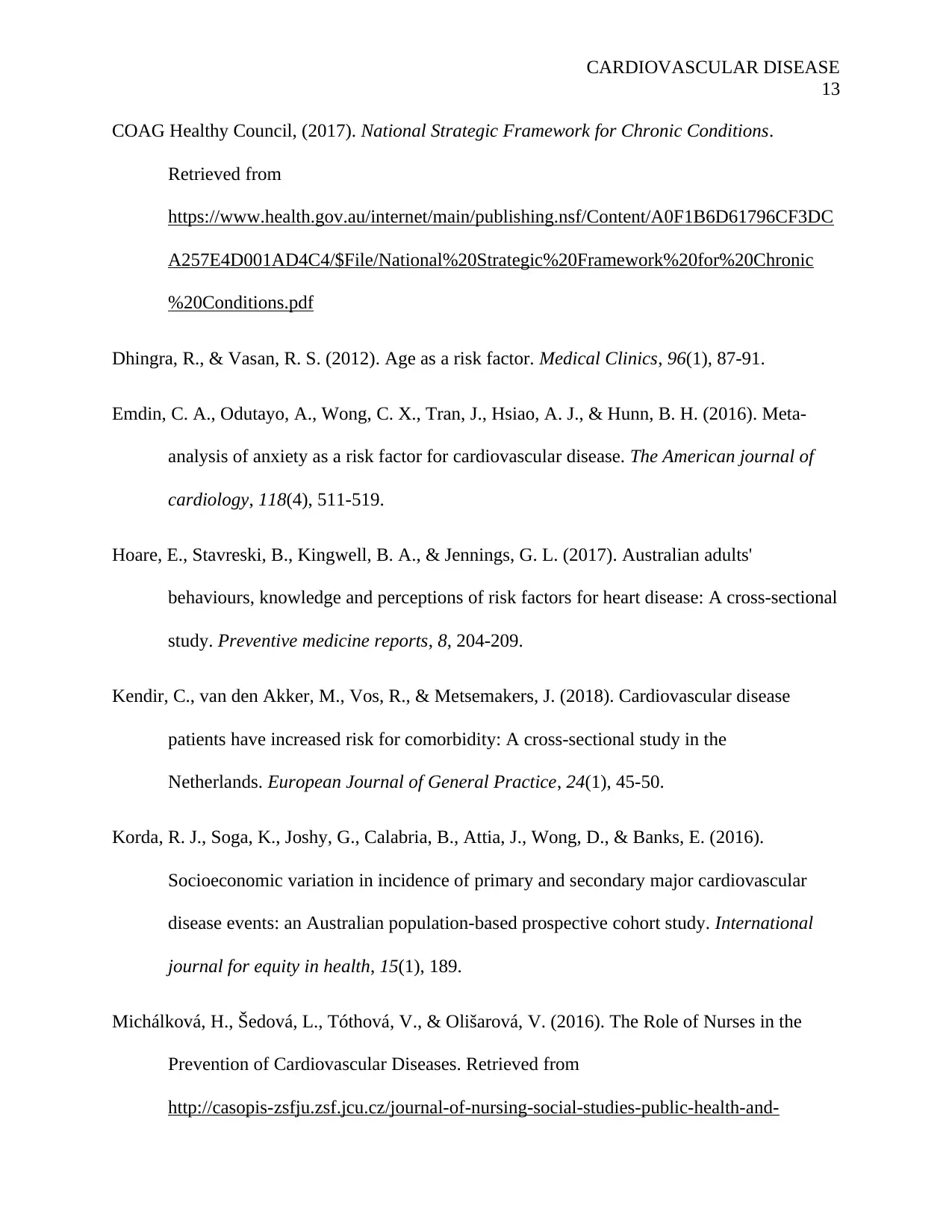
CARDIOVASCULAR DISEASE
13
COAG Healthy Council, (2017). National Strategic Framework for Chronic Conditions.
Retrieved from
https://www.health.gov.au/internet/main/publishing.nsf/Content/A0F1B6D61796CF3DC
A257E4D001AD4C4/$File/National%20Strategic%20Framework%20for%20Chronic
%20Conditions.pdf
Dhingra, R., & Vasan, R. S. (2012). Age as a risk factor. Medical Clinics, 96(1), 87-91.
Emdin, C. A., Odutayo, A., Wong, C. X., Tran, J., Hsiao, A. J., & Hunn, B. H. (2016). Meta-
analysis of anxiety as a risk factor for cardiovascular disease. The American journal of
cardiology, 118(4), 511-519.
Hoare, E., Stavreski, B., Kingwell, B. A., & Jennings, G. L. (2017). Australian adults'
behaviours, knowledge and perceptions of risk factors for heart disease: A cross-sectional
study. Preventive medicine reports, 8, 204-209.
Kendir, C., van den Akker, M., Vos, R., & Metsemakers, J. (2018). Cardiovascular disease
patients have increased risk for comorbidity: A cross-sectional study in the
Netherlands. European Journal of General Practice, 24(1), 45-50.
Korda, R. J., Soga, K., Joshy, G., Calabria, B., Attia, J., Wong, D., & Banks, E. (2016).
Socioeconomic variation in incidence of primary and secondary major cardiovascular
disease events: an Australian population-based prospective cohort study. International
journal for equity in health, 15(1), 189.
Michálková, H., Šedová, L., Tóthová, V., & Olišarová, V. (2016). The Role of Nurses in the
Prevention of Cardiovascular Diseases. Retrieved from
http://casopis-zsfju.zsf.jcu.cz/journal-of-nursing-social-studies-public-health-and-
13
COAG Healthy Council, (2017). National Strategic Framework for Chronic Conditions.
Retrieved from
https://www.health.gov.au/internet/main/publishing.nsf/Content/A0F1B6D61796CF3DC
A257E4D001AD4C4/$File/National%20Strategic%20Framework%20for%20Chronic
%20Conditions.pdf
Dhingra, R., & Vasan, R. S. (2012). Age as a risk factor. Medical Clinics, 96(1), 87-91.
Emdin, C. A., Odutayo, A., Wong, C. X., Tran, J., Hsiao, A. J., & Hunn, B. H. (2016). Meta-
analysis of anxiety as a risk factor for cardiovascular disease. The American journal of
cardiology, 118(4), 511-519.
Hoare, E., Stavreski, B., Kingwell, B. A., & Jennings, G. L. (2017). Australian adults'
behaviours, knowledge and perceptions of risk factors for heart disease: A cross-sectional
study. Preventive medicine reports, 8, 204-209.
Kendir, C., van den Akker, M., Vos, R., & Metsemakers, J. (2018). Cardiovascular disease
patients have increased risk for comorbidity: A cross-sectional study in the
Netherlands. European Journal of General Practice, 24(1), 45-50.
Korda, R. J., Soga, K., Joshy, G., Calabria, B., Attia, J., Wong, D., & Banks, E. (2016).
Socioeconomic variation in incidence of primary and secondary major cardiovascular
disease events: an Australian population-based prospective cohort study. International
journal for equity in health, 15(1), 189.
Michálková, H., Šedová, L., Tóthová, V., & Olišarová, V. (2016). The Role of Nurses in the
Prevention of Cardiovascular Diseases. Retrieved from
http://casopis-zsfju.zsf.jcu.cz/journal-of-nursing-social-studies-public-health-and-
Paraphrase This Document
Need a fresh take? Get an instant paraphrase of this document with our AI Paraphraser
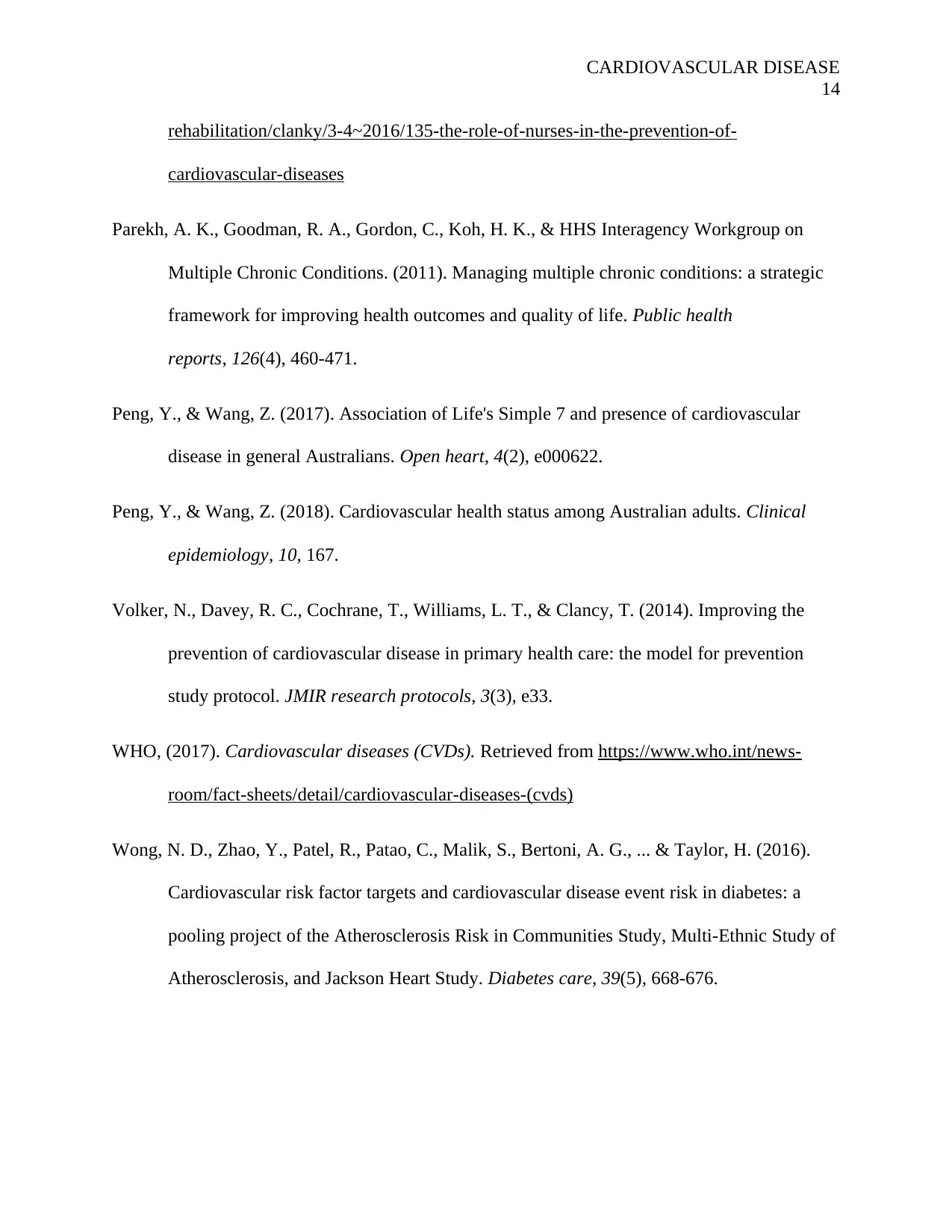
CARDIOVASCULAR DISEASE
14
rehabilitation/clanky/3-4~2016/135-the-role-of-nurses-in-the-prevention-of-
cardiovascular-diseases
Parekh, A. K., Goodman, R. A., Gordon, C., Koh, H. K., & HHS Interagency Workgroup on
Multiple Chronic Conditions. (2011). Managing multiple chronic conditions: a strategic
framework for improving health outcomes and quality of life. Public health
reports, 126(4), 460-471.
Peng, Y., & Wang, Z. (2017). Association of Life's Simple 7 and presence of cardiovascular
disease in general Australians. Open heart, 4(2), e000622.
Peng, Y., & Wang, Z. (2018). Cardiovascular health status among Australian adults. Clinical
epidemiology, 10, 167.
Volker, N., Davey, R. C., Cochrane, T., Williams, L. T., & Clancy, T. (2014). Improving the
prevention of cardiovascular disease in primary health care: the model for prevention
study protocol. JMIR research protocols, 3(3), e33.
WHO, (2017). Cardiovascular diseases (CVDs). Retrieved from https://www.who.int/news-
room/fact-sheets/detail/cardiovascular-diseases-(cvds)
Wong, N. D., Zhao, Y., Patel, R., Patao, C., Malik, S., Bertoni, A. G., ... & Taylor, H. (2016).
Cardiovascular risk factor targets and cardiovascular disease event risk in diabetes: a
pooling project of the Atherosclerosis Risk in Communities Study, Multi-Ethnic Study of
Atherosclerosis, and Jackson Heart Study. Diabetes care, 39(5), 668-676.
14
rehabilitation/clanky/3-4~2016/135-the-role-of-nurses-in-the-prevention-of-
cardiovascular-diseases
Parekh, A. K., Goodman, R. A., Gordon, C., Koh, H. K., & HHS Interagency Workgroup on
Multiple Chronic Conditions. (2011). Managing multiple chronic conditions: a strategic
framework for improving health outcomes and quality of life. Public health
reports, 126(4), 460-471.
Peng, Y., & Wang, Z. (2017). Association of Life's Simple 7 and presence of cardiovascular
disease in general Australians. Open heart, 4(2), e000622.
Peng, Y., & Wang, Z. (2018). Cardiovascular health status among Australian adults. Clinical
epidemiology, 10, 167.
Volker, N., Davey, R. C., Cochrane, T., Williams, L. T., & Clancy, T. (2014). Improving the
prevention of cardiovascular disease in primary health care: the model for prevention
study protocol. JMIR research protocols, 3(3), e33.
WHO, (2017). Cardiovascular diseases (CVDs). Retrieved from https://www.who.int/news-
room/fact-sheets/detail/cardiovascular-diseases-(cvds)
Wong, N. D., Zhao, Y., Patel, R., Patao, C., Malik, S., Bertoni, A. G., ... & Taylor, H. (2016).
Cardiovascular risk factor targets and cardiovascular disease event risk in diabetes: a
pooling project of the Atherosclerosis Risk in Communities Study, Multi-Ethnic Study of
Atherosclerosis, and Jackson Heart Study. Diabetes care, 39(5), 668-676.
1 out of 14
Related Documents
Your All-in-One AI-Powered Toolkit for Academic Success.
+13062052269
info@desklib.com
Available 24*7 on WhatsApp / Email
![[object Object]](/_next/static/media/star-bottom.7253800d.svg)
Unlock your academic potential
© 2024 | Zucol Services PVT LTD | All rights reserved.





